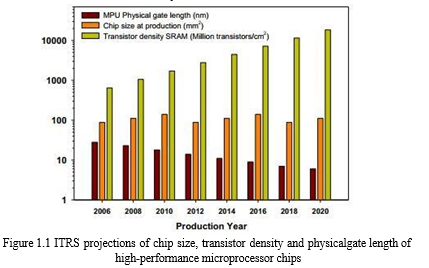Ijraset Journal For Research in Applied Science and Engineering Technology
- Home / Ijraset
- On This Page
- Abstract
- Introduction
- Conclusion
- References
- Copyright
Enhanced Cooling of VLSI Circuits Using Heat Sinks Nanofluids
Authors: Animireddy Konadababu, S Venkateswara Rao, K. Prasada Rao
DOI Link: https://doi.org/10.22214/ijraset.2024.63885
Certificate: View Certificate
Abstract
Electronic devices and chips are an integral part of the technological development in all sectors and are helpful to accelerate their growth. Due to the continuous miniaturization and developments of design of VLSI Chip (Very Large-Scale Integration), the amount of heat generation is increasing per unit volume. The increase in thermal issues due to some of the few major reasons such as high electro migration and increasing the junction temperature caused by higher performance, current flow, and compact size. This increased temperature in the electronic chip also affects the other electronic components on its neighbor. This leads to failure in the electronic devices. Consequently, poor reliability significantly reduced lifetime of the semiconductor as well as increased power consumption. Therefore, it has become inevitable to develop efficient heat sinks and heat transfer fluids capable of higher thermal conductivity and heat transfer so as to increase the processing speed of the electronic devices and VLSI Chip.In this work, the new design structure and cooling methods have been proposed based on the few research gaps as mentioned. Three different structure of channel heat sink are designed and analyzed by using CATIA v5, and commercial CFD software (ANSYS FLUENT version12) respectively. The Single-channel heatsink with ordinary water, Al2O3/water as coolants in the Single-channel heat sink at different volume concentration (0.25%, 0.50% and 0.75%)
Introduction
I. INTRODUCTION
A. Introduction
The semiconductors have significant applications in many fields such as 3D printing machine, power devices, medical therapy, optical sensors, networking, mobile technology, satellite, digital televisions, military affairs, etc., because of their compactness, high performances and low cost. Moreover, semiconductor devices such as transistors, capacitors, inductors, diode, operational amplifier, and resistors, etc., are integrated into a complex circuit to build-up macro, micro, and nano electronic circuits. The history of digital electronics fully started after the introduction of the vacuum tube. The digital electronics has seen tremendous growth after the invention of the transistor at Bell Telephone Laboratories in 1947.
TTL (Transistor-Transistor Logic) family has been the pioneer of the IC logic family since 1962. Indeed, the manufacturing of TTL components was responsible for the formation of all larger semiconductor companies such as Fairchild, National and Texas Instruments.
A few efforts have been taken gradually to develop an integrated analog and digital circuit in a single chip package. These endeavors have succeeded in producing both analog and digital ICs, as well as mixed-signal ICs. Analog ICs are multipliers, operational amplifiers, modulators/demodulators, etc., while digital ICs are AND, OR, XOR, NOR, NAND gates and so on. Digital ICs are mostly categorized based on the measures, in terms of the number of logic gates or transistors in a single package. Remarkably, the CMOS (Complementary Metal-Oxide-Semiconductor) is a type of semiconductor and belonged to MOS (Metal Oxide Semiconductor) logic gates and continued until the later part of the 1960s.
In 1972, the next revolution has begun by Intel in a digital integrated circuit with the introduction of first microprocessors. Since then the dimension of a single integrated chip has been reduced, which results in the dramatic increase in the density of transistor and electronic components used in the integrated chip. Moreover, the increase in integration and miniaturization of devices lead to Small Scale Integration (SSI) in the 1960s, which contains 1-100 transistors and fabricated on a single chip. Likewise, Medium Scale Integration (MSI) which contains100-1000 number of transistors integrated on a single chip. It was followed by a new development in the technology in1960s is a Large-Scale Integration (LSI) that offers 1000- 10000 transistors per chip (Sohel Murshed et al. 2017). Similarly, in 1980 Very Large-Scale Integration (VLSI) accommodated with 10000-1 million components and Ultra Large-Scale Integration (ULSI) with 1 million-10 million components per chip.
Gordon E. Moore, the co-founder of Intel and Fairchild semiconductor, predicted that this innovative technology would grow at a rapid pace. In 1965, Moore proposed that the number of transistors in a complex integrated circuit doubles every two years. His Prediction is commonly known as “Moore’s Law”. In addition, his prediction has accurately proved and used in semiconductor industry for research and development. VLSI design and microelectronic technologies still adhere to Moore's law such as component density, processing speed, memory capacity, chip performance, power consumption and size of pixels in digital cameras.
Figure 1.1 Shows the features of semiconductor that predicted by International Technology Roadmap for Semiconductors (ITRS) (Sohel Murshed et al. 2017). Accordingly, the size of the transistor decreases incessantly up to 6nm and the density of transistor increases up to about 20 billion transistors/cm2 by 2020.
B. Issues in VLSI Design
For the past several years, the modern semiconductor industries have developed the miniaturized semiconductor components to perform effectively in the compact electronic circuit board. The semiconductor has been contributing more in the development of the high-performance electronic chips. Similarly, the development in VLSI technology had a dramatic impact on the growth and significant improvement of wireless communication systems. In this view, wireless technology advances which have integrated both the baseband digital circuits and the RF analog circuits onto a signal monolithic integrated circuit (system on chip). Because of this some issues still remain to be unresolved such as thermal effect, noise interferences and etc. The high-density chips in MOS VLSI technology are based on scaling i.e. reduction in the size of transistors, so that high packing density can be achieved. Thus, scaling of MOSFET transistors is concerned with systematic reduction of overall dimension of the device as allowed by available technology, while at the same time preserving the geometric ratios found in the larger devices. Some of the most exciting benefits of scaling is that it not only helps to increase the switching speed but also reduce the chip size and power dissipation. However, because of scaling there is a thermal issue arising due to increase in carrier flow in the small channel length.
Even though the modern electronic chips are being designed on a miniaturized scale, their performances and operational speeds are much better than in the past. However, still, there is a drastic increase in the rate of heat also. Therefore, increase in the rate of heat generation are the leading cause of failure of these devices. In fact, the failure rate of the VLSI Chip (electronic chip) increases almost exponentially with increasing operating temperature. Consequently, there is a significant decrease in the reliability and lifetime of the semiconductor as well as its power consumption increased. Because of this impact, thermal management has become critical in the present and future generation semiconductor devices.
The heat flux of the electronic chip increased from 330 W/cm2 in 2007 to 520 W/cm2 in 2011 reported by the international technology road map for semiconductors (Bayomy et al. 2016). Simcha Gochman et al. (2003) revealed that the dissipation of heat from desktop and mobile processors is about 100W and 30W, respectively. Pedram et al. (2006) reported that most of the Integrated Circuit (IC) failures are associated with 50% of thermal issues. Thus, cooling of high heat flux in electronic devices effectively is one of the challenging tasks.
C. Use of Ansys-CFD in Electronic Cooling
Ansys CFD (Computational Fluid Dynamics) is a high-performance simulation software which provides reliable and accurate solutions quickly to evaluate the physical characteristics of design products. The three main elements in the CFD code algorithm that used to tackle the fluid flow design are preprocessor, solver, and post processor. It is a commercial CFD software package and used for different applications like 3D modelling, fluid dynamics, structural mechanics, electromagnetics, multi-physics and system simulations etc.
Consequently, it is observed that the excessive development and miniaturization of the electronic chip are still facing thermal issues, which in turn reduces the performance, reliability, and lifetime. Therefore, it is very important to develop an electronic chip cooling system to operate in the ambient temperature. Very limited research work has been carried out on the electronic chip cooling using microchannel heatsink and nanofluids.
II. MATERIALS AND METHODS
A. Materials
In this work, Distilled water and Al2O3/water nanofluids coolants were carried out to examine the heat transfer performance of single channel heat sink.
The heat transfer analysis of the channel heatsink for the electronic chip cooling was carried out with the nanofluids at different volume concentrations (0.25%, 0.50% and 0.75%). Seyed Ebrahim Ghasemi et al. (2017c) examined the heat dissipation in the micro channel heatsink based on the thermo physical properties of nanoparticles such as CuO and TiO2 as shown in the Table 2.1.
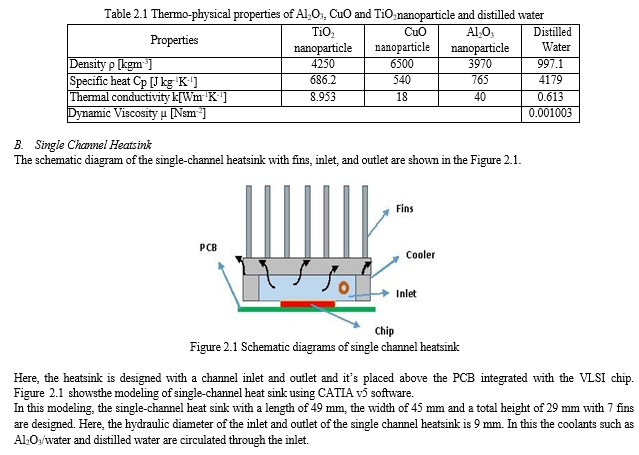
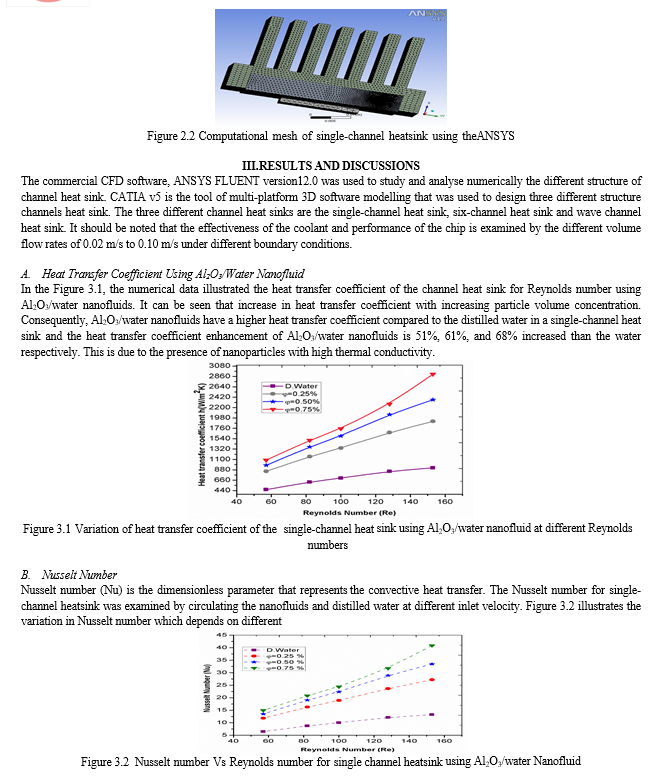
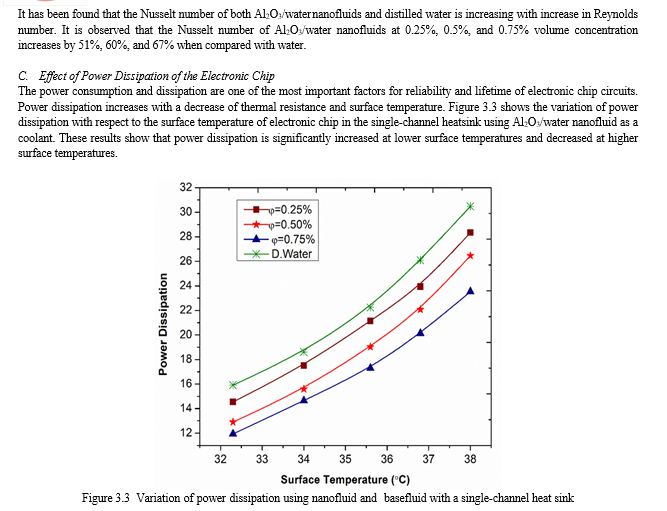
The results revealed that the power dissipation of Al2O3/water nanofluids is 17 %, 39 %, and 51% higher than base fluids at 0.25%, 0.5%, and 0.75% volume concentrations respectively. By using the coolant and heatsink has lower power dissipation and thus reduces the power consumption of the electronic chip and increases the credibility.
D. Effect of Reliability and Lifetime of the Electronic Chip
In the absence of a proper cooling system, the miniaturized VLSI Chip is subject to an increase in the junction temperature. Under these conditions, the mobility of carriers is also being increased and thereby there is an increase in the rate of electro-migration. Consequently, this can lead to the failure of electronic components in relatively short times and also reducing the circuit lifetime to an unacceptable level.
Figure 3.4 shows the variation of reliability with respect to temperature in the single-channel heatsink. It can be seen from the results that the reliability of the electronic chip is high at low temperatures and low at a higher temperature.
The numerical results also illustrate that the lifetime of the electronic chip using the coolant Al2O3/water nanofluids is higher than the water as a coolant. The reliability of an electronic chip has increased up to 70%, by using Al2O3/water nanofluids at 0.75% volume concentration, which is higher than the use of water as a coolant. The reason behind the higher reliability of an electronic chip is because it uses the nanofluids with high thermal conductivity properties and makes it an effective heat transfer.
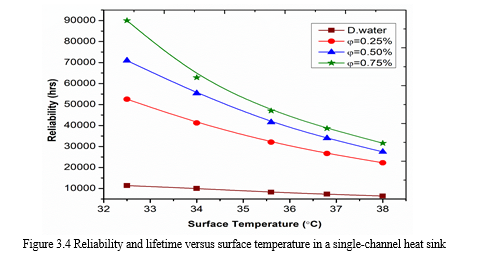
Conclusion
The following conclusions have been drawn from the proposed work: 1) It has been found that the heat transfer coefficient of nanofluids is significantly 74%, and 81% higher at 0.50% when compared to distilled water. 2) It was found that the viscosity and thermal conductivity increased with the increase of particle volume concentration. 3) It was observed that the heat transfer coefficient of the Al2O3/water nanofluids is increased by 18%, 47%, and 51% at 0.25% when compared with distilled water. 4) It was clearly observed that the heat transfer coefficient of Al2O3/water nanofluids increases by 27 %, 55 % and 61 % at a volume concentration of 0.5% when compared with distilled water. 5) It was found that the heat transfer coefficient of Al2O3/water nano fluids increased by 33%, 61% and 68% at a volume concentration of 0.75%when compared with distilled water. 6) It is observed that Al2O3/water nanofluid has a higher heat transfer coefficient than other coolants because of higher thermal conductivity. 7) The obtained results show that the heat transfer coefficient of a single channel heat sink increased by 74%, and 81% at 0.50% nanofluid. These results also show that single channel heat sinks have a better thermal performance than other channel heatsinks. 8) It is found that this high heat transfer coefficient can effectively reduce the surface temperature of the VLSI Chip.
References
[1] Abbassi, H & Aghanaja?, C 2006, ‘Evaluation of heat transfer augmentation in a nano?uid-cooled microchannel heat sink’, Journal of Fusion Energy, vol. 25, no. 3, pp. 187-196. [2] Abdullah, AAA, Al-Rashed, Amin Shahsavar, Sajad Entezari, Moghimi, MA, Adio, SA & Truong Khang Nguyen 2019, ‘Numerical investigation of non-Newtonian water CMC/CuO nano fluid flow in an offset strip-fin micro channel heat sink: Thermal performance and thermodynamic considerations’, Applied Thermal Engineering, vol. 155, pp. 247-258. [3] Adeel Muhammad, Deepak Selvakumar & Jian, W 2020, ‘Numerical investigation of laminar flow and heat transfer in a liquid metal cooled mini-channel heat sink’, International Journal of Heat and Mass Transfer, vol. 150, pp. 119265. [4] Ahmadi, MH, Nazari, MA, Ghasempour, R, Madah, H, Sha?i, MB & Ahmadi, MA 2018, ‘Thermal conductivity ratio prediction of Al2O3/water nano?uid by applying connectionist methods’, Colloids and Surfaces A: Physicochemical and Engineering Aspects, Vol. 541, pp. 154-164. [5] Ahmed Abdulnabi Imran, Nabeel Sameer Mahmoud & Hayder Mohammad Ja?al 2018, ‘Numerical and experimental investigation of heat transfer in liquid cooling serpentine mini-channel heat sink with di?erent new con?guration models’, Thermal Science and Engineering Progress, Vol.6, no. 6, pp. 128–139. [6] Alfaryjat, AA, Mohammed, HA, Mariah, N, Stanciu, D & Dobrovicescu, A 2018, ‘Numerical investigation of heat transfer enhancement using various nano fluids in hexagonal microchannel heat sink’, Thermal Science and Engineering Progress, vol. 5, pp. 252-262. [7] Ali j Chamkha, Maysam Molana, AliRahnama & Farid Ghadami 2018 ‘On the nanofluids applications in michrochannel A comprehensive review’, Powder Technology, vol. 332, no. 1, pp. 287-322. [8] Allan webber 2014, Calculating useful lifetimes of embedded processors, SPRABX4A. Available from: Texa instruments. [November 2014] [9] Al-Rashed, MH, Dzido, G, Korpys, M, Smolka, J & Wojcik, J 2016, ‘Investigation on the CPU nano?uid cooling’, Microelectronics Reliability, vol. 63, pp. 159-165. [10] Ambreen, T & Kim, MH 2018, ‘E?ect of ?n shape on the thermal performance of nano ?uid cooled micro pin-?n heat sinks’, International Journal of Heat and Mass Transfer, vol. 126, pp. 245–56 [11] Amer Al-Damook, Kapur, N, Summers, JL & Thompson, HM 2015, ‘An experimental and computational investigation of thermal air flows through perforated pin heat sinks’, Applied Thermal Engineering, vol. 89, no. 5, pp. 365-376. [12] Anbumeenakshi, C & Thansekhar, MR 2017, ‘On the e?ectiveness of a nano?uid cooled microchannel heat sink under non-uniform heating condition’, Applied Thermal Engineering, vol. 113, pp. 1437–1443. [13] Ashrafmansouri, SS & Nasr Esfahany, M 2014, ‘Mass transfer in nano?uids: a review’, International Journal of Thermal Sciences, vol. 82, pp. 84-99. [14] Bahiraei Mehdi & Hangi Morteza 2013, ‘Investigating the ef?cacy of magnetic nano?uid as a coolant in double-pipe heat exchanger in the presence of magnetic ?eld’, Energy Conversion and Management, vol. 76, pp. 1125–1133. [15] Bahiraei, M 2016, ‘Particle migration in nano?uids: a critical review’, International Journal of Thermal Sciences, vol. 109, pp. 90-113. [16] Bayomy, AM, Saghir, MZ & Yousefi, T 2016, ‘Electronic cooling using water flow in aluminum metal foam heat sink: Experimental and numerical approach’, International Journal of Thermal Sciences, vol. 109, no. 1, pp. 182–200. [17] Bedrouni, M & Khelil, A 2020, ‘Numerical Study On The Performance Of Rounded Corners On The Top Of Electronic Components On Cooling Effectiveness’, International Journal Of Heat And Mass Transfer, vol. 150, pp. 119391. [18] Brighenti, F, Kamaruzaman, N & Brandner, JJ 2013, ‘Investigation of self-similar heat sinks for liquid cooled electronics’, Applied Thermal Engineering, vol. 59, no. 1–2, pp. 725-732. [19] Brinkman, HC 1952, ‘The viscosity of concentrated suspensions and solutions’, The Journal of Chemical Physics, vol. 20, no. 4, pp. 571. [20] Chein, R & Chuang, J 2007, ‘Experimental microchannel heat sink performance studies using nano?uids’, International Journal of Thermal Science, vol. 46, no. 1, pp. 57–66.
Copyright
Copyright © 2024 Animireddy Konadababu, S Venkateswara Rao, K. Prasada Rao. This is an open access article distributed under the Creative Commons Attribution License, which permits unrestricted use, distribution, and reproduction in any medium, provided the original work is properly cited.

Download Paper
Paper Id : IJRASET63885
Publish Date : 2024-08-06
ISSN : 2321-9653
Publisher Name : IJRASET
DOI Link : Click Here
 Submit Paper Online
Submit Paper Online


